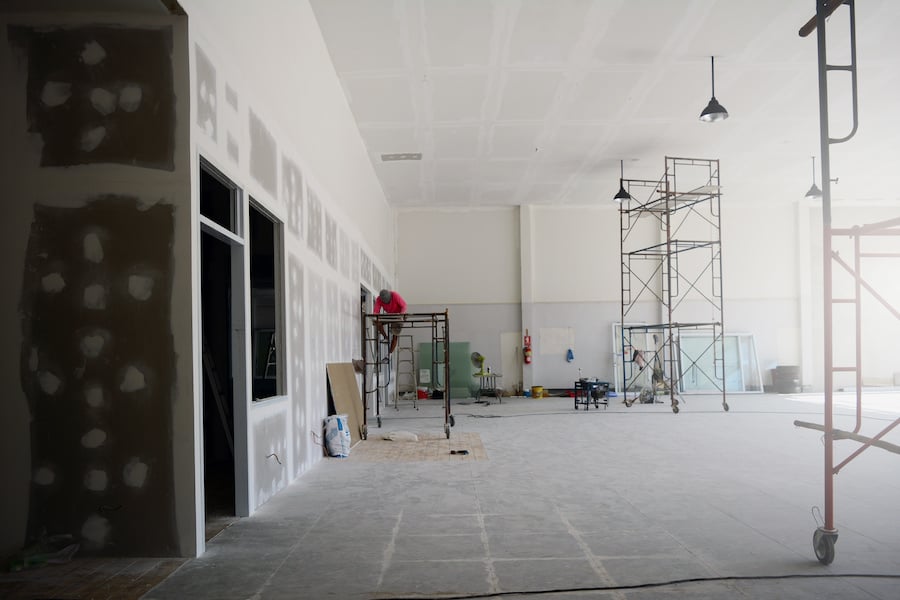Are you looking to move your business to a new commercial space? Do you know exactly what features would be in your perfect building?
There are a lot of great properties out there but don’t be discouraged if they don’t have everything you need in the state you find them.
You have room to build your ideal commercial space in the current market. Tenant improvement allowance, funded by your landlord, will give you a budget to make specific, agreed-upon alterations to the building. That way, you won’t need to go on a wild goose chase to find a property that checks all of your boxes.
If you are familiar with the tenant improvement allowance and you come prepared to negotiate, there is no limit to what you could get.

As tenant reps, we have spent countless hours working amongst the ins and outs of commercial real estate. We have been deep in the weeds of 40-80 page corporate leases and come out alive. The expertise we provide has helped our clients through every stage of the process, especially in negotiation.
We have folded our expertise in this article, so you will be equipped with the knowledge you need. So, you are prepared to make more informed decisions for your corporate real estate portfolio in the future.
What Are TI Dollars?
A tenant improvement allowance (TIA) is an agreed-upon sum of money your landlord covers to go to renovations. When you move into a building, it may likely need some work. Whether this is an extensive build-out or just fixing the normal wear and tear of previous tenants, you want to be ensured that you will not be responsible for all the costs. You don’t own the building after all, so why should you pay for all of the renovations?

It may be expensive to change a new building into a space where your company’s culture can thrive. Tenant Improvement dollars help mitigate any costs you run into during this process. Your landlord agrees to pay at least a portion of the renovations, reducing your out-of-pocket expenses.
How is the TIA Amount Determined?
While TIA dollars are traditionally a staple in corporate leases, the exact amount is largely dictated by negotiation. Generally, though, landlords will be more willing to give more TI dollars if the lease term is longer. A larger allowance means happier tenants. Happier tenants will likely remain within the landlord’s property for longer. For the landlord, this results in a more sustained, guaranteed income. Therefore, it will be worth it for them to shell out extra dollars for a stable and long term cashflow.
There are many factors to consider when negotiating for your specific allowance. It is key to come prepared because you will be responsible for renovation costs if you accept a low offer for TIA.
The current state of the building will be the foundation for negotiations. If the building is old or requires many changes, your jumping-off point for the allowance will be higher. By the same reasoning, a relatively new space or one with scuffs from prior tenants will offer a much lower sum of improvement dollars.
Many experts recommend outlining any prospective renovations and getting a bid from two to three contractors so you have a clear idea of what everything will cost. Going into negotiations with a clear estimate will reduce the likelihood that your total costs will exceed your offered TI dollars.
What Else Do I Need to Know?
It is also vital to know how tenant improvement dollars are expressed. They are typically determined by the square footage of commercial spaces. For example, a landlord may offer $20 per square foot on a 20,000-foot commercial space. This means they agree to cover $400,000 of any renovation costs you may run encounter.
If you find that the price of renovation exceeds this initial funding, you have options. You could pay out of pocket or get your own loan, but the most typical route tenants take is amortizing additional TI expenses.
An amortized tenant improvement allowance is essentially a loan provided by the landlord upfront. This sum will cover any further outlined construction costs. The tenant pays off the sum over the rest of their leasing term. The amount is integrated into your total rental rate (usually viewed as additional rent) with additional interest. Therefore, you may run into higher prices for monthly rent. However, you are not responsible for fronting all costs at once. Many tenants like having this as an option.
The downside is that amortized tenant improvement payments are subject to escalations like any other rental payment. This means the interest can add up and become extremely costly for longer terms.
Like anything else, the amount of additional TI dollars and the rate at which they are amortized, are determined by negotiations. That is why it is vital to have a skilled representative by your side throughout the entire process.
What Will My TIA Cover?
The keyword of Tenant Improvement allowance is improvement.
Landlords, like everybody else, are in the business to make money. So they aren’t going to want to cover extraneous costs the tenant may ask for.
They will, however, fund renovations that will improve the value of the building. This is generally relegated to hard costs. These are any improvements that will still be left behind in the building after you, as the tenant, leave.
Hard costs can include any significant construction feats and the labor that goes along with them. Typically this appears as building or taking down walls, new flooring, constructing spaces like kitchens, or changing lighting or electrical layout. Hard costs are not limited to this list and largely vary depending on your needs. They often include any necessary materials or adjustments to the way an old tenant may have left the space. Your landlord will normally cover these costs, whether there are marks on the wall, ripped wires, frayed carpeting, or missing ceiling tiles.
On the other hand, soft costs are generally contested by landlords. They are reluctant to fund any changes outside of the building’s framework. This means you may have to go into your pocket for furniture, general moving expenses, and any other cosmetic features for your company’s specific culture.
In negotiations, you and your landlord will agree to a list of the renovations they will cover. In this process, the value of skilled negotiation cannot be overstated. The tenant improvement allowance can be expanded to cover more costs that weren’t originally introduced. As a result, you will have more freedom to make your building the perfect fit.
Do I Pay Rent During Construction?
No!
There are specific dates to keep in mind that will be outlined in your lease and influence the timeline of you moving into your new space.
The Commencement Date is when the lease becomes binding, and the property is legally promised to you. However, before you are handed the keys to your new space, any tenant improvements have to occur.
The Delivery Date is when the build-outs have concluded, and you are free to move into your commercial property. The exact time between the Commencement Date and the Delivery Date will vary depending on how extensive your renovations are. However, you should expect that this process could take months. So, if you are planning to look for a new space- start looking now! You should account for any extra time that may be devoted to construction.
The third date is the Rent Commencement Date. This is the agreed-upon day you begin your rent payments. If there are any construction delays, the exact rent commencement date may be pushed back.
You will not pay a dime in rent until your initial tenant improvements are concluded, and the space is appropriate for you to move in. However, when renewing leases, tenants can usually negotiate new TI dollars. In this case, minor renovations and maintenance can occur as you occupy the space. Depending on how extensive the work is, your office may not have to shut down during upgrades.
How to Get the Most TI Dollars
If you feel overwhelmed about the factors surrounding TI dollars, you don’t need to.
As we discussed, the only way to seal in the tenant improvement allowance you want is through skilled negotiation. Unfortunately, this can be daunting in the wake of savvy landlords, their expensive lawyers, experienced brokers, and 80+ page leases.
The best way to come prepared to negotiate with this force is with your own representation. You need a real estate expert on your side. That is where tenant representatives come in. They employ their real estate knowledge to protect the interests of tenants solely. In this case, this means more TI dollars for you.

However, the perks and savings they find are not limited to TI dollars. The tenant rep can introduce no shortage of terms in negotiation to save you money, time, and stress.
Interested in learning more about what a tenant rep is? Learn More Here!







